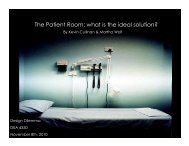The role of physical design and informal communication
The role of physical design and informal communication
The role of physical design and informal communication
You also want an ePaper? Increase the reach of your titles
YUMPU automatically turns print PDFs into web optimized ePapers that Google loves.
Joseph (2006) cites anecdotal evidence that staff members who move from a<br />
centralized unit to a decentralized unit <strong>of</strong>ten feel isolated <strong>and</strong> miss the camaraderie <strong>and</strong><br />
support <strong>of</strong> the centralized unit. A similar reaction was echoed by staff at Sutter<br />
Roseville Medical Center in Roseville, California where lack <strong>of</strong> spatial transparency in<br />
a decentralized unit inhibited interaction <strong>and</strong> collaboration among staff (Flynn &<br />
Barista, 2005). <strong>The</strong> horseshoe shaped decentralized stations left the nurses feeling<br />
isolated <strong>and</strong> unable to effectively support each other. <strong>The</strong> Clinical manager reported<br />
that the stations were so decentralized that the staff would not even know if everyone<br />
showed up for a shift. Dutta (2008) conducted a pre-post <strong>design</strong> study to assess the<br />
impact <strong>of</strong> decentralized vs. centralized nursing station layout on opportunistic<br />
<strong>communication</strong> <strong>and</strong> interaction patterns. He found that the frequency <strong>of</strong><br />
<strong>communication</strong> between medical staff decreased in a decentralized layout. In fact, in<br />
the new decentralized unit, there were 54% fewer short interactions per hour than in<br />
the old centralized unit.<br />
1.9.1.2 Location <strong>of</strong> Communication on the Nursing Unit<br />
To date, very little attention has been paid to where on the nursing unit<br />
different types <strong>of</strong> staff tend to communicate <strong>and</strong> for what reason. Developing a better<br />
underst<strong>and</strong>ing <strong>of</strong> the location <strong>of</strong> interactions could help <strong>design</strong>ers plan nursing units<br />
that better support the desired forms <strong>of</strong> <strong>communication</strong> among the multidisciplinary<br />
healthcare team. <strong>The</strong> previously cited study by Stryker (2004) that investigated the<br />
effect <strong>of</strong> workplace <strong>design</strong> on face-to-face <strong>communication</strong> found that team<br />
<strong>communication</strong> was positively related to the <strong>informal</strong> spaces – corridors, break areas,<br />
<strong>informal</strong> meeting spaces – <strong>and</strong> non-team <strong>communication</strong> was associated with formal<br />
<strong>of</strong>fice space. Stated another way, members <strong>of</strong> the team took advantage <strong>of</strong> what are<br />
commonly perceived as unproductive, ancillary areas for opportunistic<br />
22







